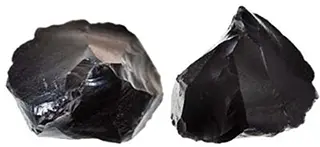
Uncovering the Origins
Obsidian, often referred to as volcanic glass, is formed from quickly cooled molten lava. It is typically black but can also appear in brown, blue, green, red-black, and other sheens due to mineral inclusions. Apache tears and snowflake obsidian are notable varieties. Found globally in volcanic regions, obsidian’s unique origins contribute to its diverse appearance.
Historical Significance and Lore
Historically, obsidian’s sharp edges made it ideal for crafting tools and weapons like arrowheads. It is less prevalent in jewelry due to its relative softness (5 on the Mohs scale) and susceptibility to scratches. The Apache tear legend speaks of the Apache tribe’s tragic loss, forming black stones where their tears fell, symbolizing enduring grief.
Healing Uses
Obsidian is known for its detoxifying properties, aiding in digestion and dissolving physical blockages. It provides relief from arthritis, joint problems, and cramps. Specific types, like Apache tear obsidian, enhance vitamin absorption, while snowflake obsidian improves circulation.
Magical Uses
This stone is recognized for its cathartic nature, surfacing deep-seated negative emotions and truths for resolution. It aids in past-life healing and absorbs environmental pollution. Placed near the bed, it draws out stress and tension, with Apache tear or snowflake obsidian being particularly effective.
Feng Shui Applications
In Feng Shui, obsidian is suitable for the northern area of a space to assist with personal journeys, and the Health/Well-Being sector for grounding and protection. Due to its negative energy absorption, it requires regular cleansing and should not be placed in neglected areas.
Personal and Spiritual Growth
Obsidian encourages confronting and integrating inner darkness. Black obsidian spheres are potent for meditation and scrying but should be used with conscious processing. Placing obsidian on the navel grounds spiritual energy, while on the third eye, it helps overcome mental barriers.
